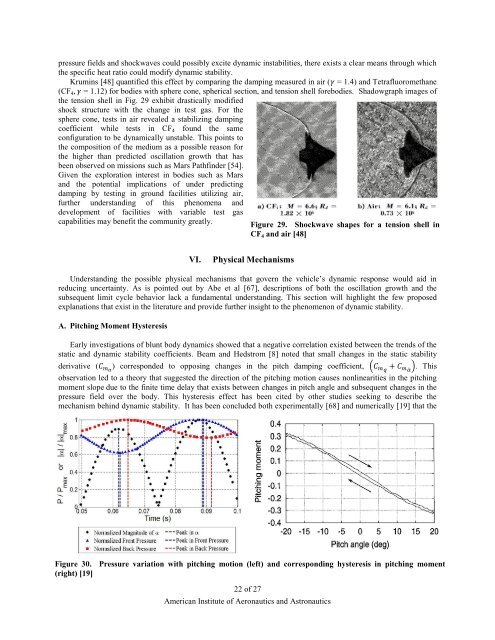Survey of Blunt Body Dynamic Stability in Supersonic Flow
Survey of Blunt Body Dynamic Stability in Supersonic Flow
Survey of Blunt Body Dynamic Stability in Supersonic Flow
Create successful ePaper yourself
Turn your PDF publications into a flip-book with our unique Google optimized e-Paper software.
pressure fields and shockwaves could possibly excite dynamic <strong>in</strong>stabilities, there exists a clear means through which<br />
the specific heat ratio could modify dynamic stability.<br />
Krum<strong>in</strong>s [48] quantified this effect by compar<strong>in</strong>g the damp<strong>in</strong>g measured <strong>in</strong> air ( = 1.4) and Tetrafluoromethane<br />
(CF 4 , = 1.12) for bodies with sphere cone, spherical section, and tension shell forebodies. Shadowgraph images <strong>of</strong><br />
the tension shell <strong>in</strong> Fig. 29 exhibit drastically modified<br />
shock structure with the change <strong>in</strong> test gas. For the<br />
sphere cone, tests <strong>in</strong> air revealed a stabiliz<strong>in</strong>g damp<strong>in</strong>g<br />
coefficient while tests <strong>in</strong> CF 4 found the same<br />
configuration to be dynamically unstable. This po<strong>in</strong>ts to<br />
the composition <strong>of</strong> the medium as a possible reason for<br />
the higher than predicted oscillation growth that has<br />
been observed on missions such as Mars Pathf<strong>in</strong>der [54].<br />
Given the exploration <strong>in</strong>terest <strong>in</strong> bodies such as Mars<br />
and the potential implications <strong>of</strong> under predict<strong>in</strong>g<br />
damp<strong>in</strong>g by test<strong>in</strong>g <strong>in</strong> ground facilities utiliz<strong>in</strong>g air,<br />
further understand<strong>in</strong>g <strong>of</strong> this phenomena and<br />
development <strong>of</strong> facilities with variable test gas<br />
capabilities may benefit the community greatly.<br />
Figure 29. Shockwave shapes for a tension shell <strong>in</strong><br />
CF 4 and air [48]<br />
VI.<br />
Physical Mechanisms<br />
Understand<strong>in</strong>g the possible physical mechanisms that govern the vehicle’s dynamic response would aid <strong>in</strong><br />
reduc<strong>in</strong>g uncerta<strong>in</strong>ty. As is po<strong>in</strong>ted out by Abe et al [67], descriptions <strong>of</strong> both the oscillation growth and the<br />
subsequent limit cycle behavior lack a fundamental understand<strong>in</strong>g. This section will highlight the few proposed<br />
explanations that exist <strong>in</strong> the literature and provide further <strong>in</strong>sight to the phenomenon <strong>of</strong> dynamic stability.<br />
A. Pitch<strong>in</strong>g Moment Hysteresis<br />
Early <strong>in</strong>vestigations <strong>of</strong> blunt body dynamics showed that a negative correlation existed between the trends <strong>of</strong> the<br />
static and dynamic stability coefficients. Beam and Hedstrom [8] noted that small changes <strong>in</strong> the static stability<br />
derivative ( ) corresponded to oppos<strong>in</strong>g changes <strong>in</strong> the pitch damp<strong>in</strong>g coefficient, (<br />
̇<br />
). This<br />
observation led to a theory that suggested the direction <strong>of</strong> the pitch<strong>in</strong>g motion causes nonl<strong>in</strong>earities <strong>in</strong> the pitch<strong>in</strong>g<br />
moment slope due to the f<strong>in</strong>ite time delay that exists between changes <strong>in</strong> pitch angle and subsequent changes <strong>in</strong> the<br />
pressure field over the body. This hysteresis effect has been cited by other studies seek<strong>in</strong>g to describe the<br />
mechanism beh<strong>in</strong>d dynamic stability. It has been concluded both experimentally [68] and numerically [19] that the<br />
Figure 30. Pressure variation with pitch<strong>in</strong>g motion (left) and correspond<strong>in</strong>g hysteresis <strong>in</strong> pitch<strong>in</strong>g moment<br />
(right) [19]<br />
22 <strong>of</strong> 27<br />
American Institute <strong>of</strong> Aeronautics and Astronautics
















